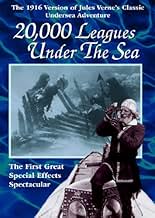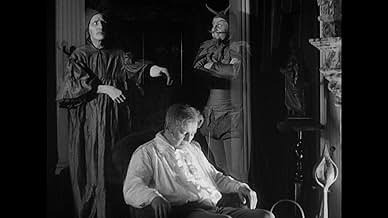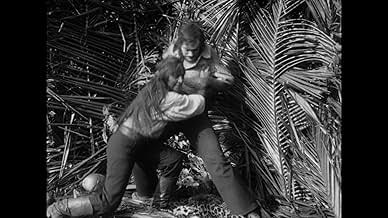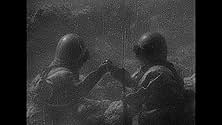IMDb RATING
6.1/10
2.2K
YOUR RATING
A French professor and his daughter accompany Captain Nemo on an adventure aboard a submarine.A French professor and his daughter accompany Captain Nemo on an adventure aboard a submarine.A French professor and his daughter accompany Captain Nemo on an adventure aboard a submarine.
- Awards
- 1 win total
William Welsh
- Charles Denver
- (as William Welch)
Wallis Clark
- Pencroft
- (as Wallace Clark)
Joseph W. Girard
- Maj. Cameron
- (uncredited)
Ole Jansen
- Undetermined Secondary Role
- (uncredited)
Noble Johnson
- Undetermined Secondary Role
- (uncredited)
Leviticus Jones
- Neb
- (uncredited)
Martin Murphy
- Herbert Brown
- (uncredited)
Jack Tornek
- Undetermined Secondary Role
- (uncredited)
- Director
- Writers
- All cast & crew
- Production, box office & more at IMDbPro
Featured reviews
This film combines plot elements of Verne's original 20,000 Leagues Under the Sea and Mysterious Island, then adds its own subplot involving the origin of Captain Nemo that ties everything together. I was very impressed by the writing. This was the first major film with underwater photography. The set design was impressive. I found the diving suits to be particularly interesting--essentially early versions of scuba gear. The new score fit very well into the story. All in all, a wonderful and landmark achievement in filmmaking.
This early adaptation of "20,000 Leagues Under the Sea" is interesting, and generally entertaining, though it lacks the depth of the original story. Its strengths are the underwater effects, the settings, and the camera work, which at times are remarkable for the era. On the other hand, it makes little attempt to convey the most important themes of Verne's story, settling instead for straightforward adventure and melodrama, which are much easier to film.
One can only guess how exciting it might have been in 1916 to see some of these images and special effects. Only occasionally does it falter a bit and lose the illusion of reality for a short time; otherwise it is quite convincing. Just seeing the underwater photography alone must have been pretty impressive at the time, and they also managed to get some interesting sea creatures on film. The photography itself is pretty good throughout the movie, and some of the props and settings are nicely done.
The story draws rather freely both from "20,000 Leagues ... " and also from another Verne story, "Mysterious Island". It is a mostly entertaining yarn, full of action and with some unexpected developments. But only a small portion of Verne's scientific vision comes across, and none of the depth of the characters and of their interactions has been preserved. Captain Nemo is one of literature's more complex and thought-provoking characters, but here he becomes more of a stock melodrama figure. Professor Arronax and Ned Land are mostly spectators, rather than providing worthy foils for the mad genius Nemo.
It's by no means a bad movie, and if you are a silent film fan and/or are interested in film history, there should be enough here to make it worth watching. But otherwise, the 1950's Disney version does a much better job of filming the profound vision and philosophical conflict found in Verne's original novel.
One can only guess how exciting it might have been in 1916 to see some of these images and special effects. Only occasionally does it falter a bit and lose the illusion of reality for a short time; otherwise it is quite convincing. Just seeing the underwater photography alone must have been pretty impressive at the time, and they also managed to get some interesting sea creatures on film. The photography itself is pretty good throughout the movie, and some of the props and settings are nicely done.
The story draws rather freely both from "20,000 Leagues ... " and also from another Verne story, "Mysterious Island". It is a mostly entertaining yarn, full of action and with some unexpected developments. But only a small portion of Verne's scientific vision comes across, and none of the depth of the characters and of their interactions has been preserved. Captain Nemo is one of literature's more complex and thought-provoking characters, but here he becomes more of a stock melodrama figure. Professor Arronax and Ned Land are mostly spectators, rather than providing worthy foils for the mad genius Nemo.
It's by no means a bad movie, and if you are a silent film fan and/or are interested in film history, there should be enough here to make it worth watching. But otherwise, the 1950's Disney version does a much better job of filming the profound vision and philosophical conflict found in Verne's original novel.
20,000 Leagues Under the Sea (1916) was a movie of firsts. It was the first feature length adaptation of Jules Vernes classic and was also the very first movie to film underwater.
Alas the troubles of this silent movie became apparent quite early on, namely that it's not exactly loyal to the source material. If you're expecting something strongly resembling the book then this may be an adaptation worth skipping over.
Now as mentioned this is a silent film (Entirely even devoid of music) which I'll be honest I've never liked. It's not anything snobbish or any expectations that I impose on a film, it's more that sitting for 90 minutes odd in silence gives me a migraine.
For this reason I watched this in sections and when the credits rolled I still managed to acquire a migraine and wasn't overly impressed with what I saw.
Considering it's age the majority looks fantastic as does the underwater filming. Certain parts struggle and it's unclear everything that is taking place but thankfully unlike 1907's version they are few and far between.
20,000 Leagues Under the Sea is a passable attempt at a grandiose tale and the first of many many adaptations.
The Good:
Revolutionary for its time
The Bad:
Something about silent film gives me a headache
Not loyal to the original book
Alas the troubles of this silent movie became apparent quite early on, namely that it's not exactly loyal to the source material. If you're expecting something strongly resembling the book then this may be an adaptation worth skipping over.
Now as mentioned this is a silent film (Entirely even devoid of music) which I'll be honest I've never liked. It's not anything snobbish or any expectations that I impose on a film, it's more that sitting for 90 minutes odd in silence gives me a migraine.
For this reason I watched this in sections and when the credits rolled I still managed to acquire a migraine and wasn't overly impressed with what I saw.
Considering it's age the majority looks fantastic as does the underwater filming. Certain parts struggle and it's unclear everything that is taking place but thankfully unlike 1907's version they are few and far between.
20,000 Leagues Under the Sea is a passable attempt at a grandiose tale and the first of many many adaptations.
The Good:
Revolutionary for its time
The Bad:
Something about silent film gives me a headache
Not loyal to the original book
I found this film extraordinary, if for no other reason than the fact, that that they used underwater photography showing divers in deep sea helmets using what looked to be rifles with spears attached (early spear guns, I imagine) actually shooting at a large group of sharks swimming around them. I also didn't see any air lines attached to any of these divers, however, if you looked closely, you could see some air bubbles come out of the helmets of the divers every so often. They must have been using some type of compressed air with a regulator, however when I queried Google, I was informed that SCUBA wasn't invented until 1939 for the US Navy and the air regulator hadn't been invented until 1943 by Jacques Cousteau. There was a device that contained compressed air in a belt attached to a diver's helmet that was invented in 1825 but that would only allow a diver to stay under 7 minutes. Were they really able to get all of the shots with the divers within that time frame. Very curious. Does anyone have the technical details for how this film was accomplished? I give this film a 9 for technology and a 5 for story line and acting for a 7 overall.
7j-cf
OK, this movie isn't at all faithful to Verne's novels (both 20000 leagues & Mysterious island), but who cares. It was too difficult for that time to stay close to the characters and to the relationship between Arronax and Nemo, which is based on the talking, showing different philosophical points of vue. So there we stick to a melodrama full of suspense and action. The pacing is quite fast, for a 1916 movie. A lot of characters and settings are involved, the cinematography is most of the time quite good and the actors are... so so. But it's the editing that attracts attention here, in a griffithian narration full of "parrallel editing" as we say in french. Some sequences are composed of four or five parallel actions, and sometimes flashbacks are used to add another dimension to the melodrama. The same fact is related three times by three different characters, each flashback being longer than its predecessor until the final revelation (that we can guess early in the film, but, as for most of gender movies, the pleasure for the viewer comes from the combination between waited events and surprising elements) narrated by Nemo himself. I don't know anything as for the origin of the version I own on DVD, so this editing question is to stay questioned. But as it is there (I saw the 1h45 version, a Jokanan copy), it's a really imaginative movie, a sort of serial with a complexer narration. It is sometimes a little boring anyway, especially when it deals with Arronax and co (Ned Land is useless, and the real hero of the movie arrives later on) and with submarine sequences (no so many, in fact, but a little childish sometimes). The documentary aspect is anyway interesting (the shark scene, an early Cousteau sequence) and from an historical point of view those sequences are very important.
A good movie, not as brilliant as the Fleischer version, but entertaining and representative of the evolution of American cinema at that time.
Just for the record: it's quite possible that the Nadia anime series by Anno Hideaki have been highly inspired by this movie (I won't say anything else, avoiding spoilers. Watch for yourself).
A good movie, not as brilliant as the Fleischer version, but entertaining and representative of the evolution of American cinema at that time.
Just for the record: it's quite possible that the Nadia anime series by Anno Hideaki have been highly inspired by this movie (I won't say anything else, avoiding spoilers. Watch for yourself).
Did you know
- TriviaUnderwater cameras were not used. The Williamson brothers had developed a system of watertight tubes and mirrors, like an upside-down periscope, and were dependent on the clarity of water and sunshine to provide the necessary light.
- GoofsIn one scene on the island the balloon survivors are at a table and a black servant appears. He never shows up again and is not rescued at the end of the film with the rest of the survivors.
- Quotes
Capt. Nemo: I am Captain Nemo and this is my submarine, 'Nautilus'... It has pleased me to save your lives... You are my prisoners.
- Crazy creditsThe opening titles announce "The First Submarine Photoplay Ever Filmed".
- Alternate versionsKino International released a video with a music soundtrack by Alexander Rannie and Brian Benison (music © 1991). Running time is 101 minutes.
- ConnectionsFeatured in Hollywood Aliens & Monsters (1997)
Details
Box office
- Budget
- $200,000 (estimated)
- Runtime
- 1h 25m(85 min)
- Sound mix
- Aspect ratio
- 1.33 : 1
Contribute to this page
Suggest an edit or add missing content


















